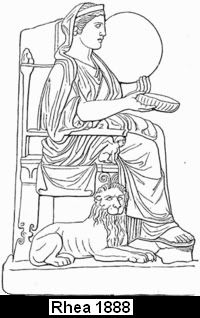Post by bluefedish on Jun 4, 2007 19:47:28 GMT -5
Rhea (ancient Greek Goddess): was the Titaness daughter of Uranus, the sky, and Gaia, the earth, in classical Greek mythology. In earlier traditions, she was strongly associated with Gaia and Cybele, the Great Goddess and later seen by the classical Greeks as the mother of the major gods and goddesses. She became sister to Cronus and mother to Demeter, Hades, Hera, Hestia, Poseidon, and Zeus. In Roman mythology, she was Magna Mater deorum Idaea and identified with Opis or, Ops.
In art, Rhea is usually depicted on a chariot drawn by two lions, and is not always distinguishable from Cybele.
Cronus, Rhea's Titan brother and, later, husband, castrated their father, Uranus. After this, Cronus re-imprisoned the Hecatonchires, the Gigantes and the Cyclopes and set the monster Campe to guard them. He and Rhea took the throne as King and Queen of the gods. This time was called the Golden Age.
Cronus sired several children by Rhea: Hestia, Demeter, Hera, Hades, Poseidon, but swallowed them all as soon as they were born, since he had learned from Gaia and Uranus that he was destined to be overcome by his own child as he had overthrown his own father. But when Zeus was about to be born, Rhea sought Uranus and Gaia to devise a plan to save him, so that Cronus would get his retribution for his acts against Uranus and his own children. Rhea gave birth to Zeus in Crete, handing Cronus a stone wrapped in swaddling clothes which he promptly swallowed.
Then she hid Zeus in a cave on Mount Ida in Crete.
In Greek mythology, Rhea's symbol is the moon. In Roman mythology, her symbol is known as "the lunar", which also would seem to mean "moon". She has another symbol, the swan, because it is a gentle animal that also is a formidable opponent.
Most often in earlier mythology, however, Rhea's symbol is two lions, the ones that pulled her celestial chariot and were seen often, rampant, one on either side of the gateways through the walls to many cities in the ancient world. The one at Mycenae is most characteristic, with the lions placed on either side of a pillar that symbolizes the goddess.


Selected Source:
en.wikipedia.org/wiki/Rhea_(mythology)
In art, Rhea is usually depicted on a chariot drawn by two lions, and is not always distinguishable from Cybele.
Cronus, Rhea's Titan brother and, later, husband, castrated their father, Uranus. After this, Cronus re-imprisoned the Hecatonchires, the Gigantes and the Cyclopes and set the monster Campe to guard them. He and Rhea took the throne as King and Queen of the gods. This time was called the Golden Age.
Cronus sired several children by Rhea: Hestia, Demeter, Hera, Hades, Poseidon, but swallowed them all as soon as they were born, since he had learned from Gaia and Uranus that he was destined to be overcome by his own child as he had overthrown his own father. But when Zeus was about to be born, Rhea sought Uranus and Gaia to devise a plan to save him, so that Cronus would get his retribution for his acts against Uranus and his own children. Rhea gave birth to Zeus in Crete, handing Cronus a stone wrapped in swaddling clothes which he promptly swallowed.
Then she hid Zeus in a cave on Mount Ida in Crete.
In Greek mythology, Rhea's symbol is the moon. In Roman mythology, her symbol is known as "the lunar", which also would seem to mean "moon". She has another symbol, the swan, because it is a gentle animal that also is a formidable opponent.
Most often in earlier mythology, however, Rhea's symbol is two lions, the ones that pulled her celestial chariot and were seen often, rampant, one on either side of the gateways through the walls to many cities in the ancient world. The one at Mycenae is most characteristic, with the lions placed on either side of a pillar that symbolizes the goddess.


Selected Source:
en.wikipedia.org/wiki/Rhea_(mythology)



